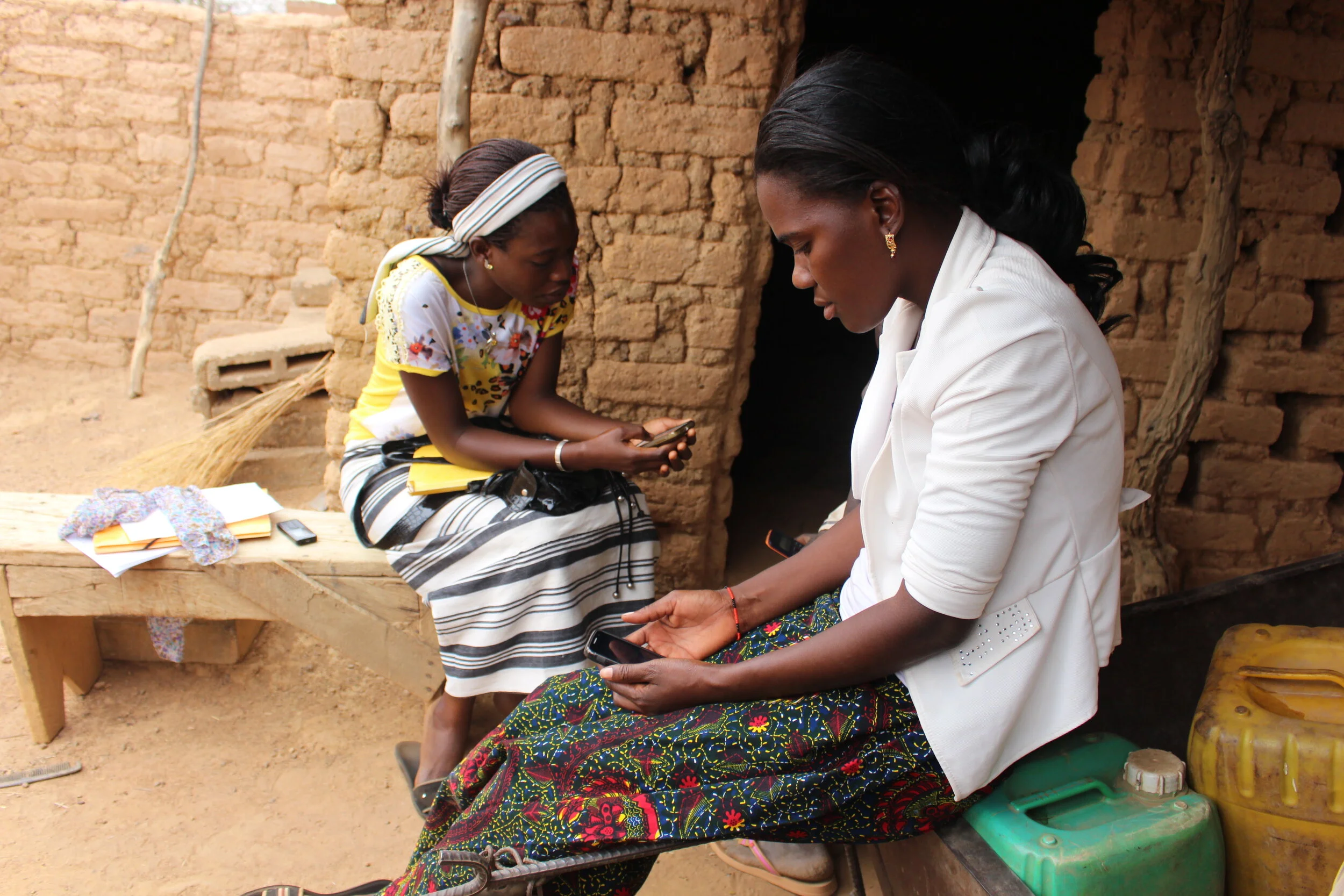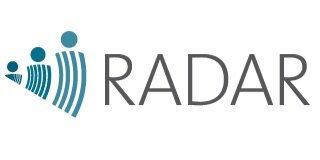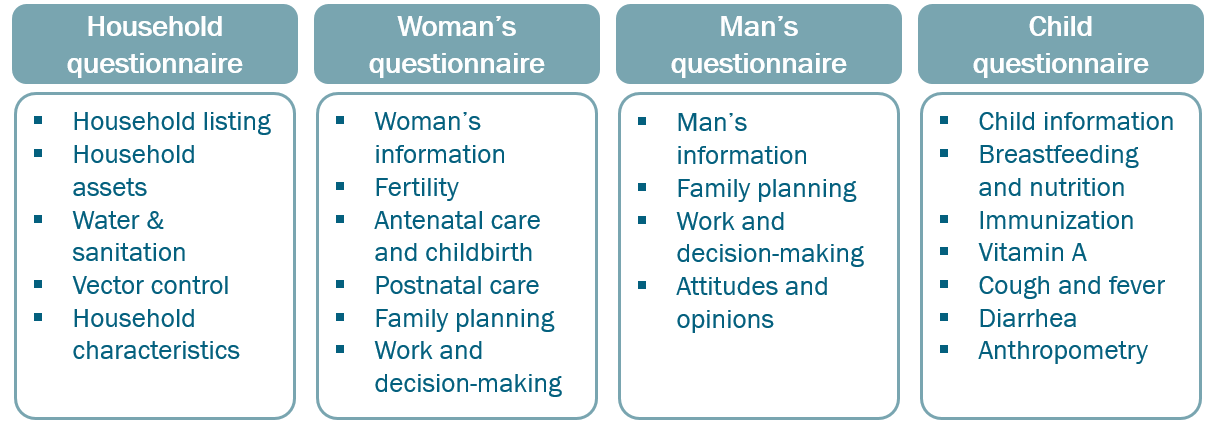
The coverage survey tool
The coverage survey tool is a set of tools that allows groups interested in collecting data from a survey area. Tools include planning tools, training tools, tools for mapping, tools to program ODK, and data monitoring and analysis tools.
Overview of Survey Process and Tools:
RADAR Questionnaire
The RADAR coverage tool is a set of questionnaires, including a household questionnaire, a woman’s questionnaire, a child’s questionnaire, and a man’s questionnaire. It aims to capture data to calculate indicators of family planning, antenatal care, childbirth, postnatal care, child health, nutrition, vector control, water and sanitation, poverty, child protection, fertility, sexual behaviour, sexual health and women’s empowerment. The questionnaire allows for sex-disaggregated and gender analyses, other equity analyses (by wealth, urban/rural, etc.), and disaggregation for specific population groups such as adolescents (provided a sufficiently large sample size is used). The questionnaire captures 20 key coverage indicators from a the Sustainable development goals (SDG), Multiple Indicator Cluster Surveys (MICS), Demographic and Health Surveys (DHS), and the President’s Emergency Plan for AIDS Relief (PEPFAR), and priority indicators from Global Affairs Canada (GAC) .
Content of the RADAR Questionnaire
RADAR Questionnaire - v.6Jan2021
RADAR Questionnaire French - v.19May2020
RADAR Key Indicator - v.20May2020
RADAR Data Quality Assessment Indicators - v.19May2020
Survey planning tools
The survey planning tools are user-friendly templates that allow users to figure out their supplies and budget. The timeline template also helps users stay on track and make sure they start activities in time to complete them by their deadlines. These tools should be used early on by the study management team, as they have implications for the rest of the study.
RADAR Budget Template - v.20June2019
RADAR Timeline Template - v.20June2019
RADAR Supply Calculator - v.20June2019
RADAR Documentation Template - v.19May2020
RADAR Deployment Plan Template - v.1Feb2021
Johns Hopkins Human Subjects Research Ethics Field Training Guide
Sampling tools
The sampling tools below allow users to develop a sample that is appropriate for collecting high quality, representative data. A well-done probability sample also has less bias than non-probability methods such as convenience, purposive, or quota sampling. The RADAR coverage survey is intended for use with probability sampling designs. Non-probability designs will not allow you to accurately measure coverage or to make inferences about changes in coverage over time.
RADAR Coverage Survey Sampling Guidelines - v.4Jun2020
RADAR Indicator Sheets - v.4Jun2020
RADAR Cluster Sampling Tool - v.4Jun2020
RADAR Household Sampling Tool - v.4Jun2020
RADAR Household Sampling App
RADAR Cluster Sampling Frame Template - v.18May2021
RADAR Sample Size Calculator
Mapping tools
The RADAR coverage survey assumes that the team will carry out mapping and enumeration in the survey area. To assist mappers and enumerators, training tools and manuals are provided here. If you want to do enumeration using CAPI, see our resources in the CAPI section below.
RADAR Mapping Manual - v.20June2019
RADAR Mapping Manual French - v.19May2020
RADAR Mapping Training Presentation - v.20June2019
RADAR Mapping Training Agenda - v.20June2019
RADAR Mapping Deployment Plan- v.20June2019
RADAR Supervisor assignment sheet and DQA- v.20June2019
Training for data collection
The tools below allow survey implementers to plan for and run comprehensive training sessions. The field manuals for both team leaders/supervisors and data collectors are meant to serve as reference documents for the individuals performing those roles during data collection, and can also serve as helpful references during data collection. The slide sets start at 2 because the first set should be a presentation of your survey, the background, the context, and of the organisations involved, and this will be highly variable. These documents are meant to be adapted to local contexts - parts to be modified are highlighted in colour.
RADAR Interviewer Manual - v.20June2019
RADAR Interviewer Manual French - v.19May2020
RADAR Team Leader / Supervisor Manual - v.20June2019
RADAR Team Leader / Supervisor Manual French - v.19May2020
RADAR Data Collector Training Agenda - v.20June2019
RADAR Team Leader Interview Observation Checklist - v.20June2019
RADAR Coverage Survey training Slide Set 2 (Training Agenda, Contents, & Manuals) - v.20June2019
RADAR Coverage Survey training Slide Set 3 (Roles and Responsibilities (R&R) of Survey Staff) - v.20June2019
RADAR Coverage Survey training Slide Set 4 (Using mapping materials for data collection) - v.20June2019
RADAR Coverage Survey training Slide Set 5 (Overview of coverage survey questionnaires) - v.20June2019
RADAR Coverage Survey training Slide Set 6 (Human subjects research ethics) - v.20June2019
RADAR Coverage Survey training Slide Set 7 (Survey supervision and quality assurance) - v.20June2019
RADAR Training Activities and Evaluations - v.19May2020
RADAR Training Homework - v.10Jul2020
RADAR Training Homework with answers - v.10Jul2020
CAPI
RADAR Coverage Survey XLS form for enumeration (mapping) for ODK - v.26May2020
RADAR Coverage Survey Enumeration form template for ODK - v. 26May2020
RADAR Coverage Survey ODK documentation - v.4Sep2020
RADAR Questionnaire XLS form for Coverage Survey - v.26May2021
Data analysis
Coming soon!
Gender analysis
The tools below will help you to integrate gender into your surveys and conduct a gender analysis of the findings. Gender analysis is the process of exploring how gender power relations led to differential access to resources, roles and practices, norms and beliefs, and decision-making power and autonomy and how these in turn affect health and health system needs, experiences, and outcomes. Gender frameworks are used to explore gender power relations – these allow us to break down the ways in which gender power relations manifest to create different and/or inequitable experiences and outcomes. Common frameworks include the Morgan et al framework and the Jhpiego framework. Questions about gender dynamics can be asked of both women and men during survey activities. Such analyses should be conducted by someone on the team with experience of conducting gender analysis.
RADAR Gender Model for Creating Gender Sensitive Indicators for Coverage, Implementation Strength, Quality of Care Surveys - v. 28May2020
RADAR Example Gender Indicators for Inclusion within Coverage Surveys - v.6Jun2020
RADAR Gender Analysis Matrix Template - v. 1Jun2020
RADAR Example Gender Analysis Matrix for Coverage, Implementation Strength and Quality of Care Surveys - v.28May2020
RADAR Gender Analysis Inference Matrix - v.28May2020
Coursera Course on Coverage surveys
RADAR has developed a free Coursera course that provides an introduction to household surveys for program evaluation in low-and middle-income countries. The course is designed for both program managers and technical staff responsible for survey planning and implementation. The course is intended to prepare learners to:
1. Explain what coverage is, why it is important in evaluations, and how it is measured
2. Describe what household surveys can and cannot measure
3. Plan, implement, and analyze household surveys including:
Calculate an appropriate household survey sample size
Explain the resources required for a household survey
Identify an appropriate sampling design
Design a questionnaire
4. Describe challenges for coverage survey planning and implementation
5. Present and describe how the RADAR tool can be used
Webinars
In May-June 2020, the RADAR Coverage team in partnership with the Canadian Partnership for Women and Children’s Health (CanWaCH) hosted a series of webinars to help users become more familiar with the RADAR Coverage survey. Recording of the sessions are available in French and English below:
The RADAR Coverage Survey Tool: A complete toolkit for implementing a household survey (French here)
The RADAR questionnaire in Open Data Kit: data analysis and processing (French here)
Going Beyond sex disaggregating: a guide to gender analyses in coverage surveys (French here)
The RADAR Coverage Survey Tool for sample size calculation and samplings (French here)








